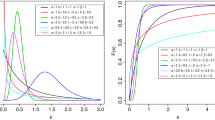Abstract
Here we propose a class of hyper-Poisson and alternative hyper-Poisson distributions and study some of its important aspects by deriving expressions for its probability mass function, mean and variance and obtain conditions under which the distribution becomes under-dispersed or over-dispersed. Certain recurrence relations for probabilities, raw moments and factorial moments are also developed. Further, the estimation of the parameters of this class of hyper-Poisson distributions is attempted by various methods of estimation and shown that this new class of distribution gives better fit to certain real life data sets compared to the existing models.

Similar content being viewed by others
References
Abramowitz, M., Stegun, I.A.: Handbook of Mathematical Functions. Dover, New York (1965)
Ahmad, M.: A short note on Conway-Maxwell-hyper Poisson distribution. Pak. J. Stat. 23, 135–137 (2007)
Bardwell, G.E., Crow, E.L.: A two parameter family of hyper-Poisson distributions. J. Am. Stat. Assoc 59, 133–141 (1964)
Crow, E.L., Bardwell, G.E.: Estimation of the parameters of the hyper-Poisson distributions. In: Patil, G.P. (ed) Classical and Contagious Discrete Distributions, pp. 127–140. Pergamon, Oxford (1965)
Hand, D.J., Daly, F., Lunn, A.D., Mc Conway, K.J., Ostrowski, E.: A Hand Book of Small Data Sets. Chapman and Hall, London (1994)
Kemp, C.D., Kemp, A.W.: Some properties of the Hermite distribution. Biomet-rika 52, 381–394 (1965)
Kemp, C.D.: q-analogues of the hyper-Poisson distribution. J. Stat. Plan. Infer. 101, 179–183 (2002)
Kumar, C.S., Nair, B.U.: A Modified version of hyper-Poisson distribution and its applications. J. Stat. Appl. 6, 23–34 (2011)
Kumar, C.S., Nair, B.U.: An alternative hyper-Poisson distribution. Statistica 3, 357–369 (2012)
Kumar, C.S., Nair, B.U.: Modified alternative hyper-Poisson distribution. In: Kumar, C.S., Chacko, M., Sathar, E.I.A. (eds) Collection of Recent Statistical Methods and Applications, pp. 97–109. Department of Statistics, University of Kerala publication, Trivandrum (2013). [ISBN: ]
Mathai, A.M., Haubold, H.J.: Special Functions for Applied Scientists. Springer, New York (2008)
Morgan, M.E., Macleod, P., Anderson, E.O., Bliss, C.I.: A sequential procedure for grading milk by microscopic counts, Storrs Agricultural. Exponential Stat. Bull. 276 (1951)
Nisida, T.: On the multiple exponential channel queuing system with hyper-Poisson arrivals. J. Oper. Res. Soc. 5, 57–66 (1962)
Roohi, A., Ahmad, M.: Estimation of the parameter of hyper-Poisson distribution using negative moments. Pak. J. Stat. 19, 99–105 (2003a)
Roohi, A., Ahmad, M.: Inverse ascending factorial moments of the hyper-Poisson probability distribution. Pak. J. Stat. 19, 273–280 (2003b)
Staff, P.J.: The displaced Poisson distribution. Aust. J. Stat. 6, 12–20 (1964)
Suhasini, A.V.S., Rao, K.S., Reddy, P.R.S.: On parallel and series non-homoge-neous bulk arrival queuing model. Opsearch (available on line) (2013)
Acknowledgments
The authors would like to express their sincere gratitude to the Managing Editor and anonymous referees for their valuable comments on an earlier version of this paper which greatly improved the quality of the paper.
Author information
Authors and Affiliations
Corresponding author
Appendix A
Appendix A
From Eq. 7 we have the first raw moment \(\mu _{1}\left (\lambda _{0}^{*}\right )= \mu _{1}(1,\lambda )\) is
by applying Eq. 9. Now by using Eq. 32, \(\mu _{1}\left (\lambda _{1}^{*}\right )= \mu _{1}(2, \lambda +1)\) can be written as
Put r = 1 in Eq. 15 to get the following.
in the light of Eq. 33 and
by definition. Equations 9 and 34 leads to the following.
By using Eq. 36, \( \mu _{2} \left (\lambda _{1}^{*} \right )=\mu _{2} (2, \lambda +1 ) \) can be written as
Put r = 2 in Eq. 15 to obtain
On substituting (33), (35) and (37) in (38), we get
in the light of Eq. 9. Next, by using (39) \( \mu _{3} \left (\lambda _{1}^{*}\right )=\mu _{3} (2, \lambda +1)\) can be written as
Put r = 3 in Eq. 15 to get
On substituting (33),(35),(37) and (40) in Eq. 41
Rights and permissions
About this article
Cite this article
Kumar, C.S., Nair, B.U. On a class of hyper-Poisson and alternative hyper-Poisson distributions. OPSEARCH 52, 86–100 (2015). https://doi.org/10.1007/s12597-013-0169-7
Accepted:
Published:
Issue Date:
DOI: https://doi.org/10.1007/s12597-013-0169-7




